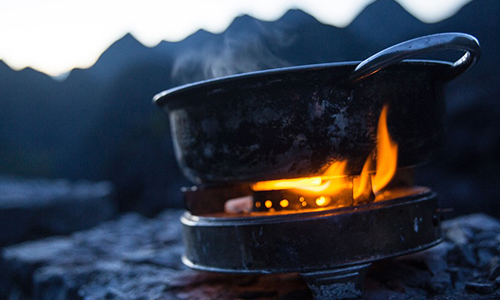Types of Gas Cylinder Regulators and How to Fit Them
Author

A keen runner, skier and nuts about cycling. Karl lives in Cumbria, where he loves encouraging his two children to follow in his outdoor lifestyle. Whilst out and about keeping active, Karl keeps a diary and shares it with Outdoor Look.
 Once you have selected your choice of gas cylinder for your stove it becomes necessary that you have the right type of regulator on it so that safety is not compromised. Also, as a precaution everyone should be aware of the steps on how to fit a regulator on a cylinder. Below are the types of regulators available in the markets that are designed for butane and propane cylinders:
Once you have selected your choice of gas cylinder for your stove it becomes necessary that you have the right type of regulator on it so that safety is not compromised. Also, as a precaution everyone should be aware of the steps on how to fit a regulator on a cylinder. Below are the types of regulators available in the markets that are designed for butane and propane cylinders:
Bolt-On Regulator
The butane gas cylinder is fitted with the calor screw regulator featuring an 8mm hose. These clip-on regulators require a spanner to fit onto a cylinder along with a screwdriver to put on the jubilee clips on the hose.
Bullnose Gas Regulator
These regulators are used on propane gas cylinders. The connector on these regulators has a left hand or an anti-clockwise thread that has to be screwed directly into the gas cylinder valve. These are available in both high and low pressure variants.
Clip-on gas Regulator
These are among the most popularly used and sit on top of a cylinder. You can either buy one for butane or a propane cylinder.
Campingas Regulators
These originated in France and are widely used in mainland Europe and UK. These enable low pressure devices and are safe and reliable.
Changeover Gas Regulators
The Changeover Gas Regulators are used in conditions where multiple cylinder units are there. This regulator immediately switches the supply from one cylinder to another when one gets empty. These are available in both automatic and manual variants.
Hoses for Regulators
These are a link between the stove and the gas cylinder and therefore must be carefully chosen and double checked for their safety.
Tips to Keep in Mind When Installing a Hose on to a Regulator
- The hose has to be pushed to the end of the regulator and the other end onto a similar connector on the camping stove.
- The hose should then be sealed by tightening the jubilee clips onto the connector area.
- For easy pushing, both ends of the hose should be soaked in hot water before putting them on the connector. This will soften the hose a little bit and make it easy for it to expand.
- The hose does not have to be removed every time change your location, it can stay on the connector.
- To check any leakage between the hose and connector, put a bit of washing liquid around the seal. In case there are bubbles coming out, then you have a gas leakage.
- When you arrive at the campsite all you have to do is to clip the regulator to the hose and check whether if all the fastenings are fitting perfectly.
Making sure that you setup a safe and affordable cooking gas mechanism would ensure a trouble free cooking experience for you and your mates or family. One should always keep check of the condition of the regulator.
Author

A keen runner, skier and nuts about cycling. Karl lives in Cumbria, where he loves encouraging his two children to follow in his outdoor lifestyle. Whilst out and about keeping active, Karl keeps a diary and shares it with Outdoor Look.
Categories
- Sport (28)
- Product Reviews (3)
- Team Outdoor Look (7)
- Mike Wild (2)
- Mike Payton (2)
- Suse Hammond-Pears (3)
- Snowboarding (12)
- Latest Offers (105)
- Shop Talk (1)
- Competitions (7)
- Walking (413)
- Lifestyle Fashion (8)
- Travel (86)
- Kit Guides (176)
- Workwear Clothing (6)
- Safety Workwear (4)
- Health/Fitness (289)
- Skiing (91)
- Great Outdoors (1316)
- Cycling (92)
- January 2025
- December 2024
- November 2024
- October 2024
- September 2024
- August 2024
- July 2024
- June 2024
- May 2024
- April 2024
- March 2024
- February 2024
- January 2024
- December 2023
- November 2023
- October 2023
- September 2023
- August 2023
- July 2023
- June 2023
- May 2023
- April 2023
- March 2023
- February 2023
- January 2023
- December 2022
- November 2022
- October 2022
- September 2022
- August 2022
- July 2022
- June 2022
- May 2022
- April 2022
- March 2022
- February 2022
- January 2022
- December 2021
- November 2021
- October 2021
- September 2021
- August 2021
- July 2021
- June 2021
- May 2021
- April 2021
- March 2021
- February 2021
- January 2021
- December 2020
- November 2020
- October 2020
- September 2020
- August 2020
- July 2020
- June 2020
- May 2020
- April 2020
- March 2020
- February 2020
- January 2020
- December 2019
- November 2019
- October 2019
- September 2019
- August 2019
- July 2019
- June 2019
- May 2019
- April 2019
- March 2019
- February 2019
- January 2019
- December 2018
- November 2018
- October 2018
- September 2018
- August 2018
- July 2018
- June 2018
- May 2018
- April 2018
- March 2018
- February 2018
- January 2018
- December 2017
- November 2017
- October 2017
- September 2017
- August 2017
- July 2017
- June 2017
- May 2017
- April 2017
- March 2017
- February 2017
- January 2017
- December 2016
- November 2016
- October 2016
- September 2016
- August 2016
- July 2016
- June 2016
- May 2016
- April 2016
- March 2016
- February 2016
- January 2016
- December 2015
- November 2015
- October 2015
- September 2015
- August 2015
- July 2015
- June 2015
- May 2015
- April 2015
- March 2015
- February 2015
- January 2015
- December 2014
- November 2014
- October 2014
- September 2014
- August 2014
- July 2014
- June 2014
- May 2014
- April 2014
- March 2014
- February 2014
- January 2014
- December 2013
- November 2013
- October 2013
- September 2013
- August 2013
- July 2013
- June 2013
- May 2013
- April 2013
- March 2013
- February 2013
- January 2013
- December 2012
- November 2012
- October 2012
- September 2012
- August 2012
- July 2012
- June 2012
- May 2012
- April 2012
- March 2012
- February 2012
- January 2012
- December 2011
- November 2011
- October 2011
- September 2011
- August 2011
- May 2010
- April 2010
- March 2010
- February 2010
- January 2010
- November 2009
- October 2009
- September 2009
Submit a Comment